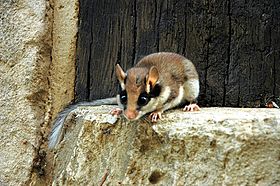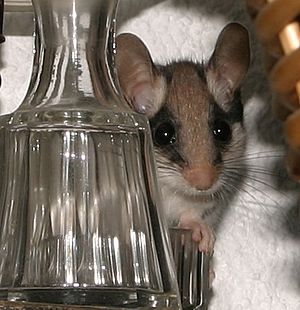Garden dormouse facts for kids
Quick facts for kids Garden dormouse |
|
|---|---|
 |
|
| Garden dormouse (Eliomys quercinus) | |
| Conservation status | |
| Scientific classification | |
| Kingdom: | |
| Phylum: | |
| Class: | |
| Subclass: | |
| Order: | |
| Suborder: | |
| Family: | |
| Genus: | |
| Species: |
E. quercinus
|
| Binomial name | |
| Eliomys quercinus Linnaeus, 1766
|
|
The garden dormouse (Eliomys quercinus) is a small rodent. It belongs to the dormouse family.
Contents
What is a Garden Dormouse?
Garden dormice are usually about 10 to 15 cm long. Their tail adds another 8 to 14.5 cm to their length. They weigh between 60 and 140 grams.
Their fur is gray or brown on top. It is white underneath their body. The garden dormouse has black marks around its eyes. It also has large ears for a rodent. Its tail has short hair and a white tassel at the end.
Where Do Garden Dormice Live?
The main home for garden dormice is the forest. They usually do not live in actual gardens. However, you can sometimes find them in areas where fruit grows.
They are very common in southern Europe. But they can be found further north too. Garden dormice often live in the Alps mountains. They also live in the Bavaria Forest and the Ore Mountains.
Garden Dormouse Populations
You can find this animal in northern Germany. But there are not many of them there. In the Netherlands, they are almost gone. In 2007, only nine garden dormice were found. They were in two woods in Limburg. This area used to have many of them.
Scientists think that changes in the land have caused this. They also believe climate change might be a reason. Climate change can stop the dormice from hibernating properly.
How Garden Dormice Live
Garden dormice are mostly active at night. During the day, they sleep in round nests. These nests are often built in trees.
At night, they search for food. They eat larger insects like grasshoppers and beetles. They also eat snails, eggs, and baby birds. Small mice and spiders are also on their menu. Besides animals, they eat berries, fruit, and nuts. Examples of nuts they eat are acorns and beechnuts.
Garden dormice are omnivores. This means they eat both plants and animals. Their diet has a bit more animal protein than plant food.
Garden Dormouse Reproduction
The time when garden dormice mate is from April to June. When a female is ready to mate, she makes loud squeaking sounds.
Baby dormice are usually born in groups of three to seven. This happens after about 23 days of pregnancy. When they are born, the babies are blind. They also do not have any fur. They open their eyes after about eighteen days.
They drink their mother's milk until they are one month old. When they are two months old, they start living on their own. They can start mating when they are one year old. Garden dormice usually live for about five years.
Sometimes, male garden dormice might eat another male dormouse. This can happen during the mating season. It can also happen when they are waking up from hibernation.
Types of Garden Dormice
There are a few types of garden dormice on the islands of the Mediterranean Sea. These types are called subspecies. They are all very hard to find.
- The Sardinian garden dormouse (E. q. sardus)
- The Sicilian garden dormouse (E. q. dichrurus)
- The Liparian garden dormouse (E. q. liparensis)
Garden dormice found in western Asia and north Africa are now seen as their own species. They are called Eliomys melanurus.
- The garden dormouse is listed as Vulnerable (VU A1c v2.3). This means it might be at risk of disappearing.
Images for kids
See also
 In Spanish: Lirón careto para niños
In Spanish: Lirón careto para niños




